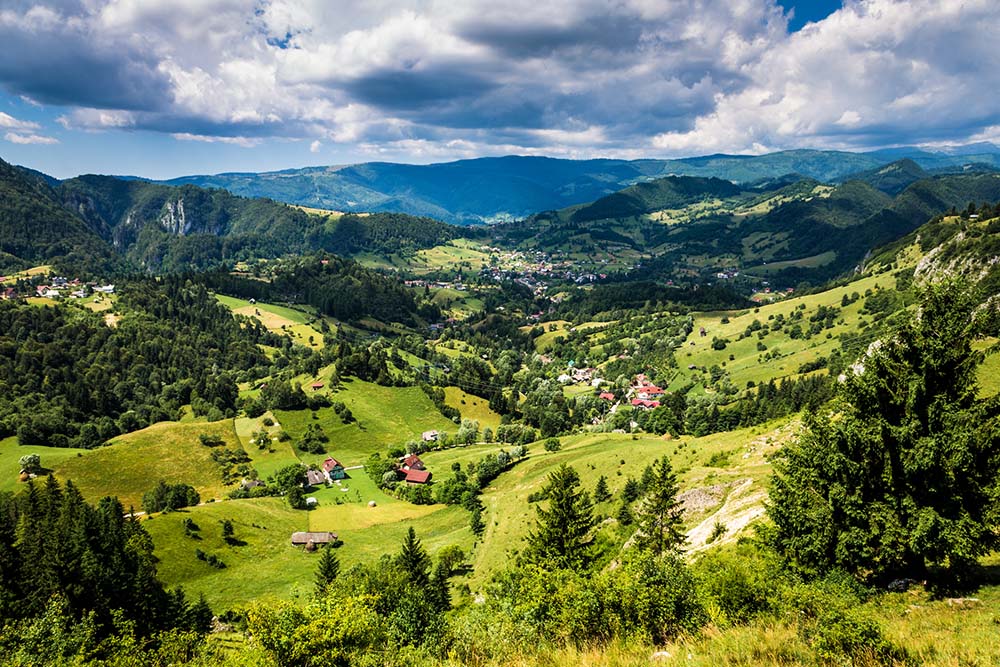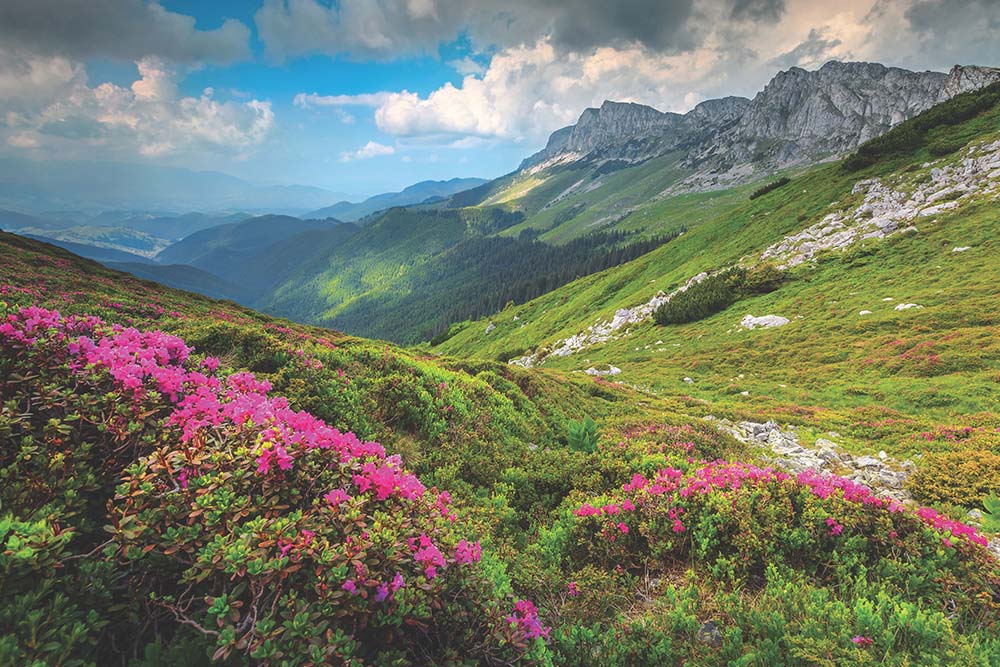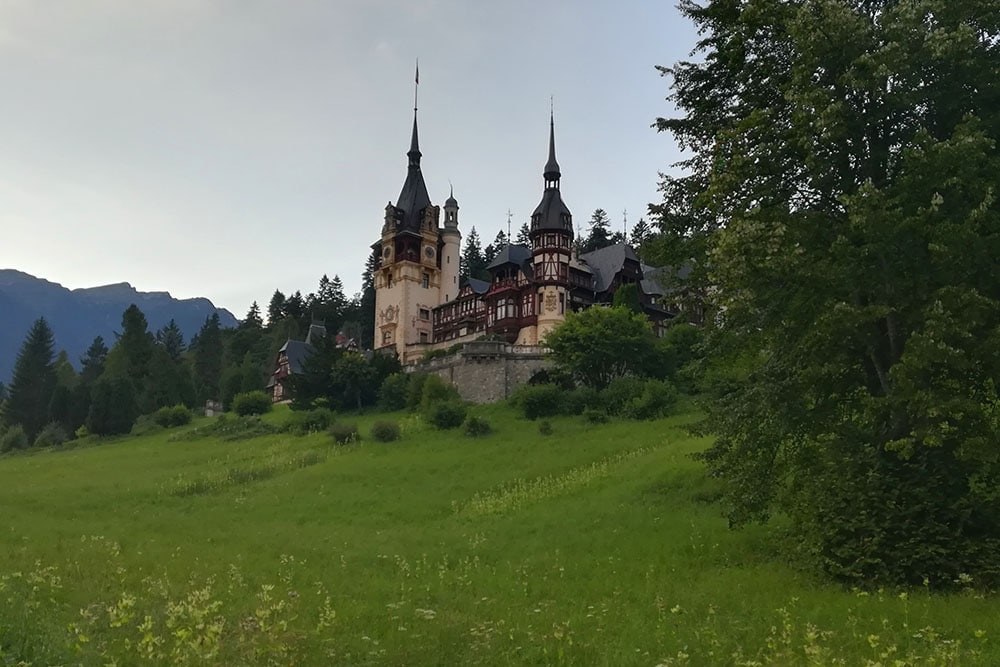
The hiking in Romania Transylvania Alps isn’t as well known as it is in places like France and Switzerland, but that’s no reason to overlook it. In fact, it’s a reason to go. Trails in Romania are far-less crowded, and there are around 35 peaks to summit, the highest of them, Moldoveanu, topping out at just 2,544 meters. Mix in the beautifully preserved forests stretching from the Carpathian Mountains to the Black Sea, the diverse wildlife, the rich folk culture, and the charming castles and medieval towns, and you’ve got a new place to add to your hiking bucket list.
Hiking in the Romania Transylvanian Alps
The best hiking in Romania is in the center of the country, in Transylvania, the fictional inspiration for Bram Stoker’s cult 1897 literary classic Dracula. The Carpathian Mountains, which stretch for more than 1500 km across Central and Eastern Europe, offer ample opportunities for hikers to leave civilization behind and travel on its well-marked trails. There are established huts at higher elevations, offering an easy place to stop and grab lunch. In the Apuseni Mountains, to the west, there are fantastic karst formations and caves.
Wildlife Lover’s Dream
Romania is a wildlife lover’s dream. The delta created by the Danube, the second largest river in Europe, creates a rich sanctuary for over 300 species of bird and 160 species of fish. Moreover, its abundant marshlands are one of the largest concentration of reed beds in the world. Four-legged creatures are easily spotted as well. The ruggedness of Romania’s mountains protected wildlife from human civilizations, and its woods are still filled with deer, elk, bear, wolves, and lynx.
The Land of Contrasts

The same hilly topography that allowed wildlife to prosper in Romania also created distinct villages. Each village has its own traditions in bread-making, pottery, tanning, and weaving. Even today, as Romania rushes head-long into the 21st century technology, its folk art traditions remain vibrant. Indeed, it is often noted that Romania is the land of contrasts, where horse carts run alongside BMW’s. This old-world charm is especially evident in the Kalibash Villages of Măgura and Peştera, which you’ll visit on your trek. The wooden churches backing up to fields of hay look like a storybook set during the Middle Ages.
Bran Castle

But that’s just the beginning of your Middle Ages tour. Romania is full of enchanting castles built during that time period. The most famous (and spooky) of these is Bran Castle, where Vlad the Impaler (inspiration for Dracula) was supposedly imprisoned. Don’t be afraid when you visit, though. While the outside looks like the setting for a perfect horror film, the inside is white-washed and filled with gardens. Along your journey, you’ll also visit delightful Sighişoara, whose fetching medieval towers, winding cobblestone streets, and outdoor markets, will entice even the busiest among us to slow down and imagine a life set during a different time.
History of Romania
Like most of Europe, both the Greeks and Romans traipsed on Romania’s shores, enticed by the easy harbors of the Black Sea. Several invasions later found Transylvania beneath the reins of the Ottoman Empire’s feudal system. It would be nearly two centuries until a peasant uprising forced Habsburg Emperor Joseph II into abolishing serfdom. In more recent times, Romania found itself navigating both World Wars. The second of which had devastating results on the country’s Jewish and Roma population. After it emerged out of communism, Romania tentatively stepped into democracy and the EU, although its membership status remains limited. (They do not use the euro, and you still need a passport to drive across its border.)
Food & Drink of Romania
Food in Romania is of the hearty variety—soups and stews and mamaliga, a hot corn dish similar to polenta. Romanians prize their desserts. They will almost always offer up treats like strudel, ice cream, crepes, or the special papanaşi, a delicious fried dough served with jam. They also cherish street food. Popular to-go items include gogoşi, or doughnuts dusted with sugar, covrigi, hot seed or salt-dusted pretzels, and mici, which is close to satay.
There are several wine-growing regions, and wine and beer are served in most restaurants. Yet, the most ubiquitous spirit in Romania is țuiça, a kind of brandy, produced mostly from plums. Indeed, as you travel through the country on your Ryder-Walker adventure, you find every town has their own special variety of țuiça. Most families have a recipe they insist is the best. Bottoms-up!









Comments are closed.